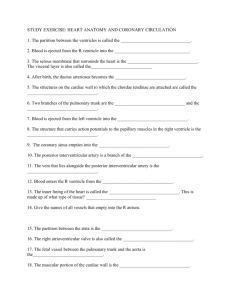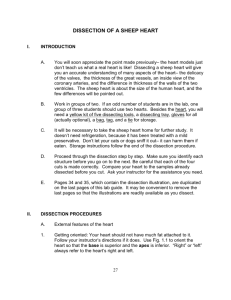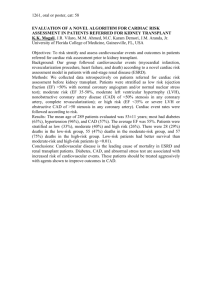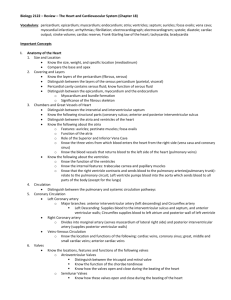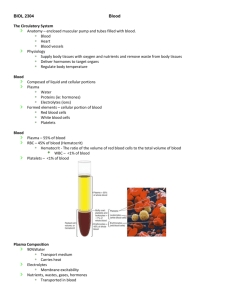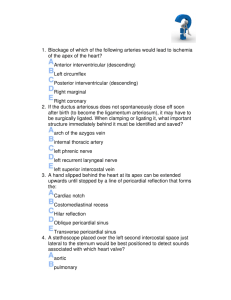Lecture Thorax class notes 2008
advertisement
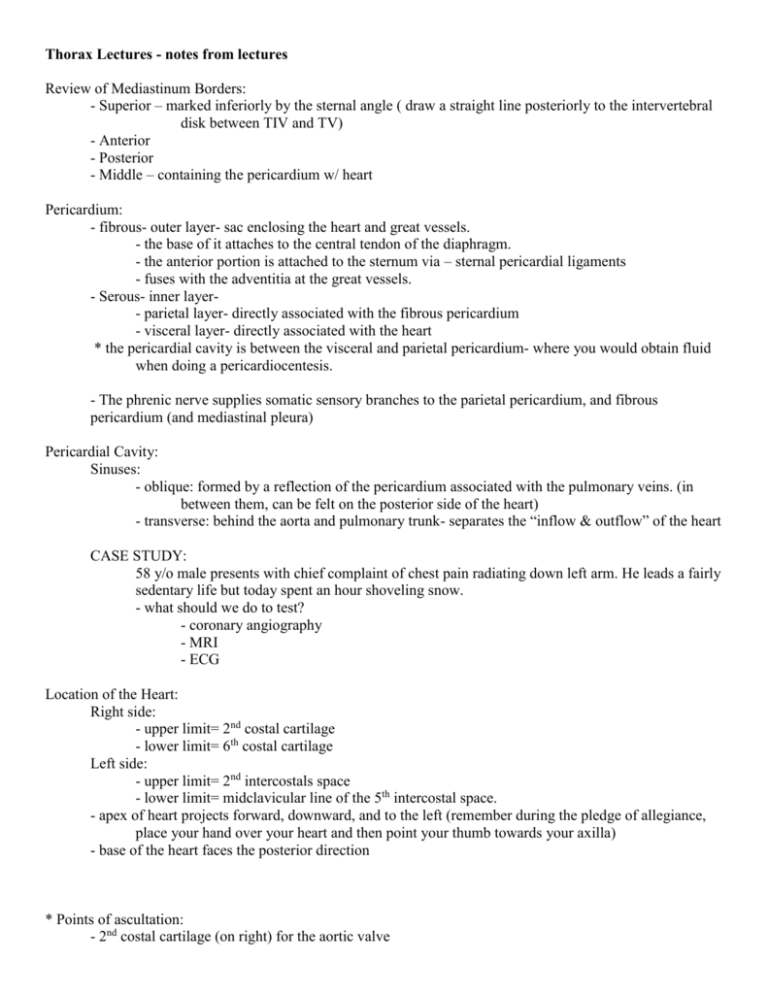
Thorax Lectures - notes from lectures Review of Mediastinum Borders: - Superior – marked inferiorly by the sternal angle ( draw a straight line posteriorly to the intervertebral disk between TIV and TV) - Anterior - Posterior - Middle – containing the pericardium w/ heart Pericardium: - fibrous- outer layer- sac enclosing the heart and great vessels. - the base of it attaches to the central tendon of the diaphragm. - the anterior portion is attached to the sternum via – sternal pericardial ligaments - fuses with the adventitia at the great vessels. - Serous- inner layer- parietal layer- directly associated with the fibrous pericardium - visceral layer- directly associated with the heart * the pericardial cavity is between the visceral and parietal pericardium- where you would obtain fluid when doing a pericardiocentesis. - The phrenic nerve supplies somatic sensory branches to the parietal pericardium, and fibrous pericardium (and mediastinal pleura) Pericardial Cavity: Sinuses: - oblique: formed by a reflection of the pericardium associated with the pulmonary veins. (in between them, can be felt on the posterior side of the heart) - transverse: behind the aorta and pulmonary trunk- separates the “inflow & outflow” of the heart CASE STUDY: 58 y/o male presents with chief complaint of chest pain radiating down left arm. He leads a fairly sedentary life but today spent an hour shoveling snow. - what should we do to test? - coronary angiography - MRI - ECG Location of the Heart: Right side: - upper limit= 2nd costal cartilage - lower limit= 6th costal cartilage Left side: - upper limit= 2nd intercostals space - lower limit= midclavicular line of the 5th intercostal space. - apex of heart projects forward, downward, and to the left (remember during the pledge of allegiance, place your hand over your heart and then point your thumb towards your axilla) - base of the heart faces the posterior direction * Points of ascultation: - 2nd costal cartilage (on right) for the aortic valve - L. side, 5th intercostals space, midclavicular line- mitral/bicuspid valve - L. side, 2nd intercostals space, pulmonary valve - L. side 4th intercostals for the tricuspid valve General Orientation of the heart: - don’t pay too much attention, just be able to recognize the general orientation. - know that the left ventricle makes the most contact with the central tendon of the diaphragm. Chambers and Valves: - 2 atria - 2 ventricles Btw: LA & LV- bicuspid (mitral) valve - 2 leaflets – anterior and posterior - associated with the chordae tendinae and papillary muscles. - these work to prevent backflow by limiting the width of the opening Btw: RA & RV- tricuspid - 3 leaflets- anterior, posterior and septal - also have chordae tendinae and papillary muscles Btw: LA & Aorta- aortic semilunar valve - posterior, right and left – cusps Btw: LV & Pulmonary trunk – pulmonary semilunar valve. - anterior, right and left- cusps * originated from the truncus arteriosus: splits and two sets of valves are formed. Fibrous Skeleton of the heart: Fxns: to support the valves. - serves as an attachment point for cardiac muscle Can be found surrounding any of the valves. * these can calcify later in life & become brittle Right Atrium: - blood comes into the right atrium from the sup. Vena cava, and inf. Vena cava – from the body. - blood also comes from the coronary sinus, returning blood from the cardiac muscle and tissues. - Crista terminalis (barrier between the two) - musculi pectinati: rough appearing muscle - sinus venarium: smooth appearing muscle. - intraarterial septum: - fossa ovalis (formerly the foramen ovale) Right Ventricle: - trabeculae carnae: rough wall of the ventricle - moderator band (septomarginal trabeculae): carries some electrical impulses. - Tricuspid Valve Complex: - as the wall of the atria contracts it pushes blood towards the ventricle, where contraction then pushes blood to the pulmonary trunk. - Chordae Tendinae: attach to the wall of the ventricle at the papillary muscles (3 sets, anterior, posterior and septal)- form a mesh like network, that prevents the valve from opening too far. Gross Anatomy 30: Thorax II Left Atrium: - Smaller than the right atrium - Arises mostly from the incorporation of the four pulmonary veins (this area is smooth) - Contains very little pectinate muscle, unlike the right atrium - Forms anatomical base of the heart - Contains the fossa ovale (formerly the foramen ovale in fetus) Left Ventricle: - Contains only anterior and posterior papillary muscles (unlike the right ventricle which also has a septal papillary muscle) - The mitral valve is comprised of two cusps which guard the opening and is surrounded by a ring of the fibrous annulus. The valve cusps are prevented from prolapsing into the left atrium by the chordae tendineae which are attached to the papillary muscles. - The left ventricle has a thicker wall than the right due to the fact that it has to pump blood over a longer distance. Cardiac Monitoring - See picture on page 169 of Gray’s - “P” is atrial depolarization - “Q”, “R”, and “S” are ventricle depolarization Cardiac Muscle Orientation - Muscles have a “whirling” pattern (think about wringing out a towel); it originates at the bottom and goes upward to move blood up and out toward the great vessels. Conducting System of the Heart - Cardiac muscle is capable of spontaneously contracting, but needs to be coordinated. - SA node is the pacemaker; coordinates contraction and sends depolarization waves to the AV node AV bundle, bundle of His (interventricular septum) muscular septum left and right bundle branches apex purkinje fibers (no depolarization occurs until the wave reaches the apex…remember “whirling” from bottom to top) - Part of the bundle branch goes through the septomarginal trabecula (moderator band) and to papillary muscles. Coronary Arteries - The coronary arteries originate inside the semilunar cusps of the aortic valve. Inside the cusps there are sinuses and the left and right coronary arteries originate from the left and right sinuses, respectively. Right Coronary Artery - The right coronary artery has three major branches: the sino-atrial branch, the right marginal branch, and the posterior interventricular branch(NOTE: The posterior interventricular branch can come off either the right or left coronary artery depending upon whether the heart is right or left dominant). - The Sino-atrial branch of the right coronary artery supplies the SA node…this is important! Without proper blood supply the SA node won’t function and the heart will not contract. - The right marginal branch of the coronary artery supplies the right ventricle - The posterior interventricular branch give blood to the interventricular septum and the ventricles (mainly the left). Left Coronary Artery - The left coronary artery has three main branches: the anterior interventricular branch (left anterior descending – LAD or “Widowmaker”), the circumflex branch, and the left marginal branch (comes off the circumflex branch) - The LAD also gives off a number of diagonal branches (usually 1-2) - The circumflex branch is located posterior to the pulmonary trunk - The left coronary artery and its branches supply blood to the left ventricle, mainly. Cardiac Veins - The majority of venous blood from the heart drains into the right atrium via the coronary sinus; the anterior veins of the right ventricle are the exception as they usually drain directly into the right atrium. - The great cardiac vein runs with the anterior interventricular artery - The middle cardiac vein runs with the posterior interventricular artery - The small cardiac vein runs with the right marginal artery - The posterior cardiac vein runs to the left of the middle cardiac vein. Sympathetic Innervation Cardiac Plexus - Visceral pain = general visceral afferents (GVAs) - Somatic pain = general somatic afferents (GSAs) - Pathway of each to CNS: o GVA sympathetic chain ganglion posterior root ganglion posterior horn synapse o GSA anterior ramus posterior ganglion posterior horn synapse - Visceral pain is general, often corresponds to specific somatic pain. As the neurons synapse at the same spot the brain interpets the merged signals as somatic pain (e.g. pain which radiates down left arm during MI). - Example: irriated pericardium which is innervated by phrenic n. (C3, C4, C5) corresponds to neck dermatomes and causes a referred neck pain. Cardiac Innervation - Cardiac plexus: superficial part is inferior to the aortic arch and between it and the pulmonary trunk - Parasympathetic: slows rhythm and rate of conduction, reduces force of contraction, constricts coronary arteries (Rest & Digest); all parasympathetic in the thorax is supplied by vagus nerve. Thorax 3/ Gross Anatomy 31 Note: Dr. stuck to his powerpoints mostly, referring to the notes he added to the bottom of them. The items listed below are additional to what he has written in his slides. Slide 4: The thymus gland is a well vascularized endocrine gland that makes T cells and is very important for the immune system. Slide 5: Contents of mediastinum: 1) Retrosternal- behind sternum - Thymus - Great veins 2) Intermediate Structures (Middle) - Aortic arch and great branches - Nerves (vagus, phrenic, sympathetic branches) 3) Prevertebral- anterior to vertebra - Trachea- bifurcates at T4/5 - Espophagus - Left recurrent laryngeal nerve - Thoracic duct - Lymph nodes Slide 7: The jugular veins drain blood from the head and neck. The subclavian veins drain blood from the UE. Slide 8: Diagram of aortic arch with the upper veins. The brachiocephalic artery branches into the R. subclavian artery and the R. common carotid artery. Cutting the recurrent laryngeal nerve would result in hoarse voice. Slide 9: Transverse section through aortic arch. Notice how compact the structures in the left diagram are. In the X-Ray, note that the trachea appears black because it contains air and the arch of the aorta appears white because it contains blood. Slide 10: Thoracic aorta: The left and right bronchial arteries supply blood to the respiratory tissue. Slide 11: Note that this diagram of the azygos system of veins is an ideal picture and this it is highly unlikely that you will find this in a person. The azygos vein empties into the superior vena cava. Slide 14: Thoracic duct: cisterna chyli collects dietary fats and is located on the lumbar vertebra. Slide 17: The left vagus nerve sends the left recurrent laryngeal nerve under the aortic arch. Slide 18: The right recurrent laryngeal nerve passes under the R. sublclavian artery. Slide 20: Know the levels of the sympathetic branches!! - Greater Splanchnic- T5-9 - Lesser Splanchnic- T10-11 - Least Splanchnic- T12

